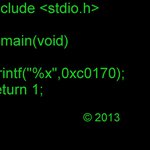mbed library sources. Supersedes mbed-src.
Dependents: Nucleo_Hello_Encoder BLE_iBeaconScan AM1805_DEMO DISCO-F429ZI_ExportTemplate1 ... more
targets/TARGET_GigaDevice/TARGET_GD32F30X/sleep.c
- Committer:
- AnnaBridge
- Date:
- 2019-02-20
- Revision:
- 189:f392fc9709a3
File content as of revision 189:f392fc9709a3:
/* mbed Microcontroller Library
* Copyright (c) 2018 GigaDevice Semiconductor Inc.
*
* SPDX-License-Identifier: Apache-2.0
*
* Licensed under the Apache License, Version 2.0 (the "License");
* you may not use this file except in compliance with the License.
* You may obtain a copy of the License at
*
* http://www.apache.org/licenses/LICENSE-2.0
*
* Unless required by applicable law or agreed to in writing, software
* distributed under the License is distributed on an "AS IS" BASIS,
* WITHOUT WARRANTIES OR CONDITIONS OF ANY KIND, either express or implied.
* See the License for the specific language governing permissions and
* limitations under the License.
*/
#if DEVICE_SLEEP
#include "sleep_api.h"
#include "us_ticker_api.h"
#include "mbed_critical.h"
#include "mbed_error.h"
extern void ticker_timer_data_save(void);
extern void ticker_timer_data_restore(void);
extern int serial_busy_state_check(void);
/*!
\brief configure the system clock to 120M by PLL which selects HXTAL(25M) as its clock source
\param[in] none
\param[out] none
\retval none
*/
static void system_clock_120m_hxtal(void)
{
uint32_t timeout = 0U;
uint32_t stab_flag = 0U;
/* enable HXTAL */
RCU_CTL |= RCU_CTL_HXTALEN;
/* wait until HXTAL is stable or the startup time is longer than HXTAL_STARTUP_TIMEOUT */
do {
timeout++;
stab_flag = (RCU_CTL & RCU_CTL_HXTALSTB);
} while ((0U == stab_flag) && (HXTAL_STARTUP_TIMEOUT != timeout));
/* if fail */
if (0U == (RCU_CTL & RCU_CTL_HXTALSTB)) {
while (1) {
}
}
RCU_APB1EN |= RCU_APB1EN_PMUEN;
PMU_CTL |= PMU_CTL_LDOVS;
/* HXTAL is stable */
/* AHB = SYSCLK */
RCU_CFG0 |= RCU_AHB_CKSYS_DIV1;
/* APB2 = AHB/1 */
RCU_CFG0 |= RCU_APB2_CKAHB_DIV1;
/* APB1 = AHB/2 */
RCU_CFG0 |= RCU_APB1_CKAHB_DIV2;
#if (defined(GD32F30X_HD) || defined(GD32F30X_XD))
/* select HXTAL/2 as clock source */
RCU_CFG0 &= ~(RCU_CFG0_PLLSEL | RCU_CFG0_PREDV0);
RCU_CFG0 |= (RCU_PLLSRC_HXTAL_IRC48M | RCU_CFG0_PREDV0);
/* CK_PLL = (CK_HXTAL/2) * 30 = 120 MHz */
RCU_CFG0 &= ~(RCU_CFG0_PLLMF | RCU_CFG0_PLLMF_4 | RCU_CFG0_PLLMF_5);
RCU_CFG0 |= RCU_PLL_MUL30;
#elif defined(GD32F30X_CL)
/* CK_PLL = (CK_PREDIV0) * 30 = 120 MHz */
RCU_CFG0 &= ~(RCU_CFG0_PLLMF | RCU_CFG0_PLLMF_4 | RCU_CFG0_PLLMF_5);
RCU_CFG0 |= (RCU_PLLSRC_HXTAL_IRC48M | RCU_PLL_MUL30);
/* CK_PREDIV0 = (CK_HXTAL)/5 *8 /10 = 4 MHz */
RCU_CFG1 &= ~(RCU_CFG1_PLLPRESEL | RCU_CFG1_PREDV0SEL | RCU_CFG1_PLL1MF | RCU_CFG1_PREDV1 | RCU_CFG1_PREDV0);
RCU_CFG1 |= (RCU_PLLPRESRC_HXTAL | RCU_PREDV0SRC_CKPLL1 | RCU_PLL1_MUL8 | RCU_PREDV1_DIV5 | RCU_PREDV0_DIV10);
/* enable PLL1 */
RCU_CTL |= RCU_CTL_PLL1EN;
/* wait till PLL1 is ready */
while ((RCU_CTL & RCU_CTL_PLL1STB) == 0U) {
}
#endif /* GD32F30X_HD and GD32F30X_XD */
/* enable PLL */
RCU_CTL |= RCU_CTL_PLLEN;
/* wait until PLL is stable */
while (0U == (RCU_CTL & RCU_CTL_PLLSTB)) {
}
/* enable the high-drive to extend the clock frequency to 120 MHz */
PMU_CTL |= PMU_CTL_HDEN;
while (0U == (PMU_CS & PMU_CS_HDRF)) {
}
/* select the high-drive mode */
PMU_CTL |= PMU_CTL_HDS;
while (0U == (PMU_CS & PMU_CS_HDSRF)) {
}
/* select PLL as system clock */
RCU_CFG0 &= ~RCU_CFG0_SCS;
RCU_CFG0 |= RCU_CKSYSSRC_PLL;
/* wait until PLL is selected as system clock */
while (0U == (RCU_CFG0 & RCU_SCSS_PLL)) {
}
}
/** Send the microcontroller to sleep
*
* The processor is setup ready for sleep, and sent to sleep. In this mode, the
* system clock to the core is stopped until a reset or an interrupt occurs. This eliminates
* dynamic power used by the processor, memory systems and buses. The processor, peripheral and
* memory state are maintained, and the peripherals continue to work and can generate interrupts.
*
* The processor can be woken up by any internal peripheral interrupt or external pin interrupt.
*
* The wake-up time shall be less than 10 us.
*
*/
void hal_sleep(void)
{
/* Disable Interrupts */
core_util_critical_section_enter();
/* Enter SLEEP mode */
pmu_to_sleepmode(WFI_CMD);
/* Enable Interrupts */
core_util_critical_section_exit();
}
/** Send the microcontroller to deep sleep
*
* This processor is setup ready for deep sleep, and sent to sleep using __WFI(). This mode
* has the same sleep features as sleep plus it powers down peripherals and high frequency clocks.
* All state is still maintained.
*
* The processor can only be woken up by low power ticker, RTC, an external interrupt on a pin or a watchdog timer.
*
* The wake-up time shall be less than 10 ms.
*/
void hal_deepsleep(void)
{
if (0 != serial_busy_state_check()) {
return;
}
/* Disable Interrupts */
core_util_critical_section_enter();
ticker_timer_data_save();
/* Enter DEEP SLEEP mode */
rcu_periph_clock_enable(RCU_PMU);
pmu_to_deepsleepmode(PMU_LDO_NORMAL, WFI_CMD);
/* Reconfigure the PLL after weak up */
system_clock_120m_hxtal();
ticker_timer_data_restore();
/* Enable Interrupts */
core_util_critical_section_exit();
}
#endif /* DEVICE_SLEEP */
 mbed official
mbed official




